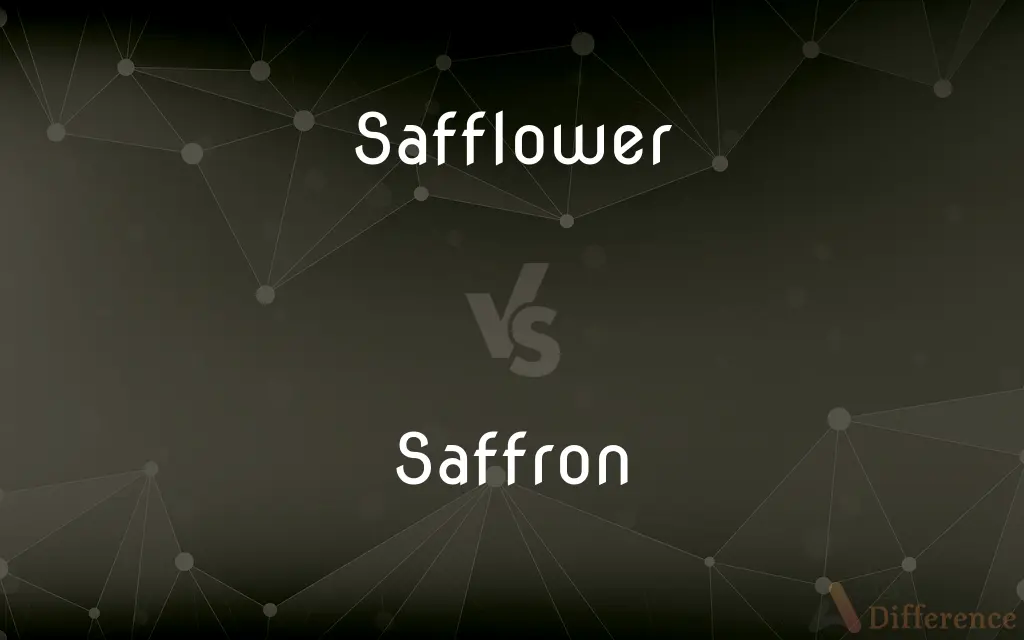Safflower vs. Saffron — What's the Difference?
By Tayyaba Rehman — Updated on November 2, 2023
Safflower is a thistle-like plant with seeds used for oil. Saffron is a spice from crocus flower stigmas, prized for flavor and color.

Difference Between Safflower and Saffron
Table of Contents
ADVERTISEMENT
Key Differences
Safflower is a plant with high oil content in its seeds, while saffron is a spice derived from the stigmas of the Crocus sativus flower. Both are often associated with their intense coloring capabilities; safflower for its oil and meal used as a cheaper dye alternative, and saffron for its deep red stigmas that impart a rich golden hue to dishes.
Safflower oil is widely used in cooking and in the manufacture of paints and cosmetics, owing to its beneficial fatty acid content. Saffron, being the world's most expensive spice by weight, is treasured in culinary traditions for its unique aroma, flavor, and color. It requires a labor-intensive process to harvest, which significantly adds to its value.
In the kitchen, safflower oil is appreciated for its neutral flavor and high smoke point, making it versatile for frying and salad dressings. Saffron, on the other hand, is revered for the distinctive taste and vibrant color it brings to dishes such as risottos, paellas, and biryanis. A small amount of saffron goes a long way due to its strong coloring and flavoring properties.
Nutritionally, safflower seeds are high in polyunsaturated fats, which can contribute to heart health when used in moderation. Saffron contains several chemical compounds like crocin, picrocrocin, and safranal, which are believed to have antioxidant, antidepressant, and anti-inflammatory properties, though these benefits require consumption in larger amounts than typically used in cooking.
Environmentally, safflower is grown as a crop in dry climates and is known for its hardy nature, while the cultivation of saffron is more delicate, requiring specific climatic conditions and careful hand-harvesting, reflecting in its premium price and the reverence with which it is treated in various cultures.
ADVERTISEMENT
Comparison Chart
Plant Type
Thistle-like plant
Crocus flower
Part Used
Seeds for oil
Stigmas for spice
Culinary Use
Cooking oil and colorant
Spice for flavor and color
Harvesting
Mechanized seed collection
Labor-intensive stigma collection
Price
Relatively inexpensive
One of the most expensive spices
Nutritional Benefit
High in polyunsaturated fats
Contains antioxidants, potential health benefits
Compare with Definitions
Safflower
The flower is used as a cheaper alternative to saffron for coloring.
He used safflower petals to achieve the yellow hue in the fabric.
Saffron
Known as one of the most expensive spices in the world.
She used the saffron sparingly, aware of its high cost.
Safflower
An annual thistle-like plant in the sunflower family.
The field was bright with the yellow and orange blooms of safflower.
Saffron
A spice derived from the stigmas of the saffron crocus.
The saffron gave the risotto its signature golden color.
Safflower
A plant cultivated for its oil-rich seeds.
They replaced their usual cooking oil with safflower oil for a healthier diet.
Saffron
Prized for its unique flavor and coloring ability.
A pinch of saffron is enough to flavor a whole pot of rice.
Safflower
It has a high smoke point, making it suitable for frying.
Safflower oil is my choice for deep-frying due to its stability at high temperatures.
Saffron
Contains the carotenoid pigment crocin, which imparts a rich color.
The paella's vibrant hue comes from the crocin in saffron.
Safflower
Safflower seeds are bird-friendly and often used in bird feed.
The backyard bird feeder was filled with safflower seeds to attract finches.
Saffron
Saffron (pronounced or ) is a spice derived from the flower of Crocus sativus, commonly known as the "saffron crocus". The vivid crimson stigma and styles, called threads, are collected and dried for use mainly as a seasoning and colouring agent in food.
Safflower
Safflower, Carthamus tinctorius, is a highly branched, herbaceous, thistle-like annual plant. It is commercially cultivated for vegetable oil extracted from the seeds and was used by the early Spanish colonies along the Rio Grande as a substitute for saffron.
Saffron
A corm-producing plant (Crocus sativus) native to the eastern Mediterranean region, having purple or white flowers with orange stigmas.
Safflower
A thistlelike Eurasian plant (Carthamus tinctorius) in the composite family, having orange flowers that produce seeds containing an oil used for cooking and in food products, cosmetics, and paints.
Saffron
The dried aromatic stigmas of this plant, used to color foods and as a cooking spice and dyestuff.
Safflower
The dried flowers of this plant, formerly used as a source of yellow and orange dyes.
Saffron
A moderate or strong orange yellow to moderate orange.
Safflower
A cultivated thistle-like plant, Carthamus tinctorius, family Asteraceae, now grown mainly for its oil.
Saffron
The plant Crocus sativus, a crocus.
Safflower
An annual composite plant (Carthamus tinctorius), the flowers of which are used as a dyestuff and in making rouge; bastard, or false, saffron.
Saffron
A spice (seasoning) and colouring agent made from the stigma and part of the style of the plant, sometimes or formerly also used as a dye and insect repellent.
Safflower
The dried flowers of the Carthamus tinctorius.
Saffron
An orange-yellow colour, the colour of a lion's pelt.
Safflower
A dyestuff from these flowers. See Safranin (b).
Saffron
Having an orange-yellow colour.
Safflower
Thistlelike Eurasian plant widely grown for its red or orange flower heads and seeds that yield a valuable oil
Saffron
To add saffron to (a food), for taste, colour etc.
Saffroned water, saffroned rice.
Saffron
To give a saffron colour to (something).
Saffron
To dye (a fabric, garment, etc.) with a saffron-based dye.
Saffron
To colour (a metal or wooden surface) with a gilding product containing saffron.
Saffron
(figuratively) To embellish.
Saffron
A bulbous iridaceous plant (Crocus sativus) having blue flowers with large yellow stigmas. See Crocus.
Saffron
The aromatic, pungent, dried stigmas, usually with part of the stile, of the Crocus sativus. Saffron is used in cookery, and in coloring confectionery, liquors, varnishes, etc., and was formerly much used in medicine.
Saffron
An orange or deep yellow color, like that of the stigmas of the Crocus sativus.
Saffron
Having the color of the stigmas of saffron flowers; deep orange-yellow; as, a saffron face; a saffron streamer.
Saffron
To give color and flavor to, as by means of saffron; to spice.
And in Latyn I speak a wordes few,To saffron with my predication.
Saffron
Old World crocus having purple or white flowers with aromatic pungent orange stigmas used in flavoring food
Saffron
Dried pungent stigmas of the Old World saffron crocus
Saffron
A shade of yellow tinged with orange
Saffron
Used historically as a dye and in traditional medicine.
Saffron robes were traditionally worn by Buddhist monks.
Common Curiosities
Can safflower and saffron be used interchangeably?
No, they have different flavors and properties and are not interchangeable.
What is saffron used for?
Saffron is used as a spice for flavoring and coloring food.
Why is saffron so expensive?
Saffron is expensive due to the labor-intensive process of harvesting the stigmas by hand.
Is safflower oil healthy?
Safflower oil can be healthy when used in moderation, particularly the high-oleic varieties.
Can I grow safflower in my garden?
Yes, safflower can be grown in gardens, particularly in dry climates.
What does safflower taste like?
Safflower oil has a neutral, mild taste, making it versatile for various culinary uses.
What is safflower used for?
Safflower is mainly used for its oil, in cooking and in products like paints and cosmetics.
What does saffron taste like?
Saffron has a subtle earthy flavor with floral hints and a slightly bitter undertone.
What are the health benefits of safflower oil?
It's high in unsaturated fats, which may support cardiovascular health.
How do you store safflower oil?
Store safflower oil in a cool, dark place, tightly sealed, to prevent rancidity.
How much saffron should be used in cooking?
A very small amount, usually measured in threads or by the pinch, due to its strong flavor.
What are the health benefits of saffron?
Saffron is believed to have antioxidant properties and may offer some digestive and mental health benefits.
Can I grow saffron in my garden?
Saffron can be grown in gardens, but it requires specific conditions and is labor-intensive.
How do you store saffron?
Saffron should be stored in an airtight container away from light to maintain its potency.
Can safflower be used as a saffron substitute?
Safflower can mimic saffron's color to some extent, but not its unique flavor.
Share Your Discovery

Previous Comparison
Temporally vs. Temporarily
Next Comparison
Length vs. HeightAuthor Spotlight
Written by
Tayyaba RehmanTayyaba Rehman is a distinguished writer, currently serving as a primary contributor to askdifference.com. As a researcher in semantics and etymology, Tayyaba's passion for the complexity of languages and their distinctions has found a perfect home on the platform. Tayyaba delves into the intricacies of language, distinguishing between commonly confused words and phrases, thereby providing clarity for readers worldwide.















































